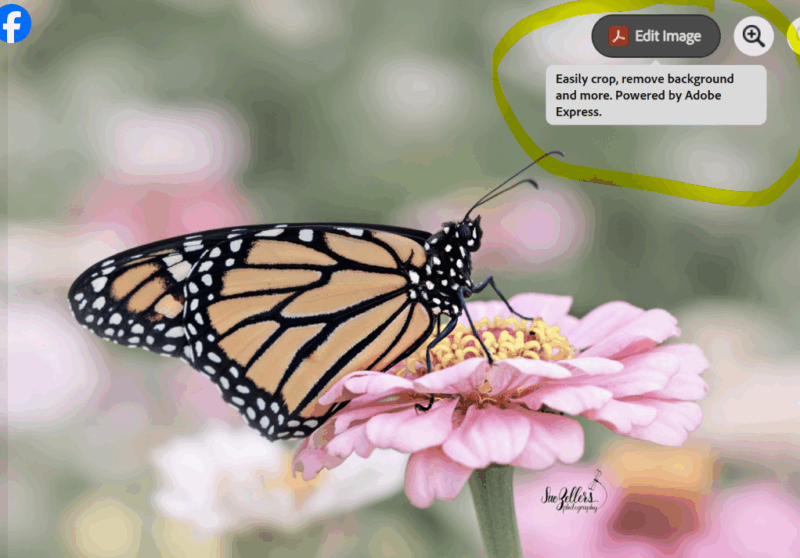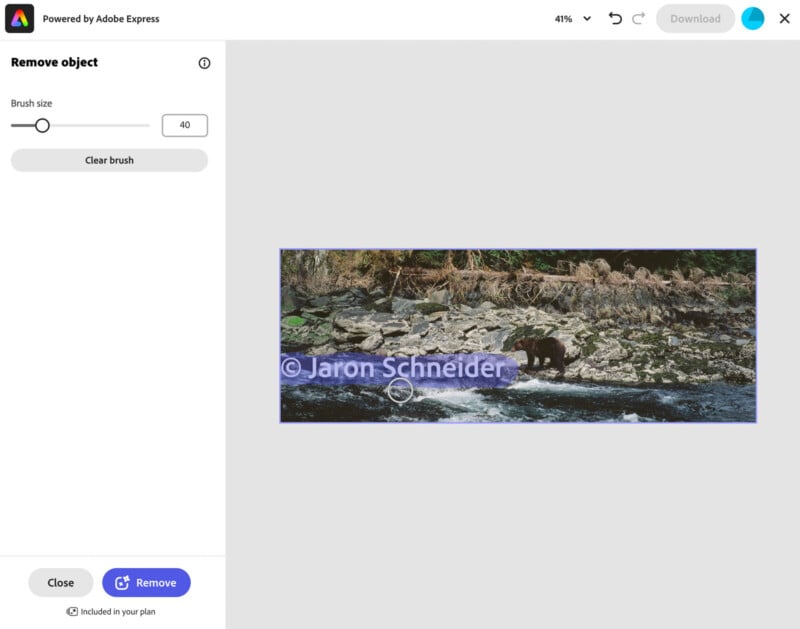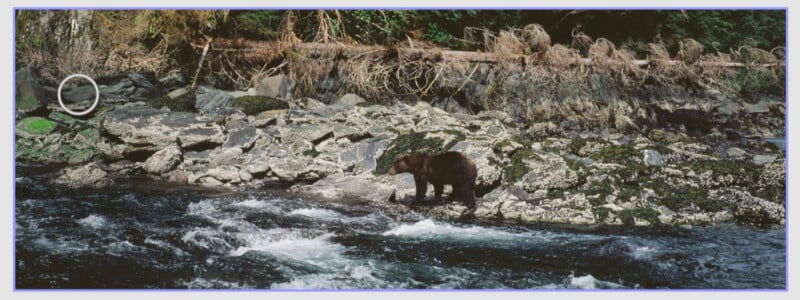Adobe’s Chrome Extension Makes Stealing Watermarked Photos Easy
![]()
Adobe has an official Chrome Acrobat extension designed and marketed for viewing, editing, and filling PDF files inside Google’s popular web browser. However, as a photographer discovered, the extension enables some far-reaching Adobe Express integration that makes removing watermarks from photos an AI-assisted cakewalk.
More broadly, the extension actively encourages users to take, edit, and use photos found online, raising serious questions about copyright. It’s troubling how a company that serves artists as its primary customer would roll out a feature that pushes users to steal.
Adobe Express Is Integrated Into an Acrobat Extension for Some Reason
A concerned PetaPixel reader recently emailed our tip line after noticing that when browsing Facebook on Chrome, she was seeing an Adobe logo on photos, prompting her to edit other people’s images using Adobe Express. We figured out that it is related to an Adobe extension in Chrome but, oddly, it’s not an Express extension, as no such one is currently available. Instead, Express inexplicably connects to a popular Acrobat extension.
If you search for “Adobe Express Chrome extension” on Google, an article does pop up that mentions editing images inside Chrome using Express, but the actual link leads to a “What’s new in Adobe Express” article, which does not have anything to do with an Express extension in Chrome. Searching for an “Express extension” on Adobe’s Help website also renders no results.
![]()
Nonetheless, despite there not being an Express-specific extension in the Chrome Extension store, and Adobe not explaining how it works on its website, Express is easily accessible in Chrome for any users who have the Adobe Acrobat extension installed. This extension, which Google says has over 320 million users, makes no mention of Adobe Express at all on its store listing. The description specifically and exclusively talks about PDF files, not photos.

What the Acrobat Extension Enables Chrome Users to Do
PetaPixel installed the Acrobat Chrome extension and easily replicated our reader’s experience on Facebook and nearly all websites on Chrome. Once this extension is installed, if the connected Adobe account has Express access, editing photos inside Express within Chrome is rarely more than two clicks away.

For example, when reading one of our articles, I can right-click on a photo, and right there in the drop-down is an invitation “Edit image,” powered by Adobe Express. If I opt to do so, Adobe Express on the Web opens up on that same tab, and I can access a wide selection of Express’s image editing tools, including crop, remove background, erase, remove object, insert object, and more.

Removing Watermarks and Stealing Photos
Perhaps most concerning of all is the Adobe Firefly-powered erase tool. Using this, removing a photographer’s watermark from an image is very easy. When browsing the web, including a photographer’s website or social media account, it is possible to delete a photographer’s watermark and download the image for any purpose, including theft, in just a few clicks and in under a minute.

Of course, it has, and will always be, possible to download a person’s photo, whether through a simple “Save As” command or screenshot, open it in the photo editing application of your choice, and remove a watermark. However, the issue with the Adobe Acrobat Chrome extension and its undocumented Express integration is that it significantly lowers the barrier and makes swiping photos even easier.

![]()

The Acrobat extension also makes it equally easy to outright edit someone else’s work with basically no image editing skills nor any permission. Using Adobe’s AI, I can remove the background of a portrait someone else captured and place the subject in a different situation and introduce all-new objects to the scene. While there are numerous safeguards in place with Adobe’s AI technology, it is still possible to misrepresent someone else’s work quite easily.
Not Very Artist-Friendly
Since PetaPixel first heard of this extension, we have been in contact with Adobe to try to figure out what’s going on here and explain why we believe a Chrome extension like this runs afoul of the company’s general obligations toward visual artists. Anything that makes stealing people’s work easier — including watermarked photos — is bad, especially when it’s developed by a company that caters so heavily toward artists.
We have yet to receive an official comment from Adobe on the Chrome extension despite repeated requests.
In the event Adobe offers any information, this story will be updated. Meanwhile, the reader who initially alerted us has been trying to obtain an explanation through Adobe’s public-facing support channels, including web chats and phone calls. So far, nobody has been able to explain the situation to her, and nobody she has spoken to has had even basic awareness that it was possible to edit photos in Express inside Chrome using the Acrobat extension at all.
That said, after days of trying to get an answer, the reader said that Adobe did finally respond in a way that makes it clear the company understands the severity of this issue.
This response juxtaposed with a week’s worth of waiting for Adobe’s official media channels to provide PetaPixel with a comment is particularly frustrating. Adobe admits this is a problem, knows the exact cause, and hasn’t made any public-facing moves to address it.
Interestingly, last week, when testing the Chrome extension for myself, I used it to remove watermarks from stock photos on Getty Images’ website to see if it was possible. It was.
I mentioned this to Adobe over email as part of our attempts to communicate with the company. In the days since, someone, somewhere, whether at Adobe or Getty, has done something to disable this functionality. However, it still works on other stock photography websites. We can only assume that a change was made in response to PetaPixel‘s shared information and can take it as confirmation that emails are being read, even though Adobe has not offered official comment on the Chrome extension and its implications for photographers.
The most reliable way at this time for people to prevent someone from easily stealing their work is to turn off right-click permissions on their personal websites. That will prevent someone from opening an image directly in Adobe Express, at least with next to no effort. I can still bypass that by using screenshots and opening the image in Express on the Web manually, which is not too different from how people can steal semi-protected content online already.
Another way to deal with content theft is for browsers to institute some type of DRM technology, like what some streaming platforms use to prevent screenshots and screen recording of proprietary web content.
The fact that I can no longer instantly remove a watermark from a photo on Getty Images without going out of my way suggests that other things can be done behind the scenes to slow an Adobe Express user from easily editing, downloading, and stealing copyright-protected photos inside Google Chrome.
Image Theft in a Few Clicks Makes it Hard to Be a Photographer Online
However, the broader issues remain. It is never good for photographers when a company, let alone one like Adobe, makes it even easier than it already is for someone to steal their work. Extensions like this make it even more challenging for photographers to exist online without living in constant fear that someone can manipulate or steal their images, even when they make reasonable attempts to protect themselves, such as using watermarks.
It’s not even clear why Adobe added this functionality into a browser-based PDF editor. It doesn’t even make any sense to be part of Acrobat, notwithstanding the ethical issues outlined above.
Whether amateur or professional, having your photos stolen online is a miserable experience. At least it used to take people some effort to remove watermarks. Adobe has ensured that’s no longer true. Anyone can wander around the internet, scrubbing and downloading photos, without any effort or even opening a separate app. The Chrome extension and its underlying technology are extremely unfriendly to photographers in a landscape that is already very challenging to navigate.
Image credits: Grizzly bear photo by Jaron Schneider. Header photo created using assets licensed via Depositphotos.